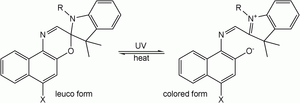today's word: photochromism
hahaha. i finally received a nicely-drawn caricature of phoelix today (thanx, sam jr, haha). too bad he wasn't able to illustrate my favorite characteristic of phoelix: photochromism.
o-kaay. let's see what wikipedia has to say about the word for the day, shall we?...
* * *hahaha. i finally received a nicely-drawn caricature of phoelix today (thanx, sam jr, haha). too bad he wasn't able to illustrate my favorite characteristic of phoelix: photochromism.
o-kaay. let's see what wikipedia has to say about the word for the day, shall we?...
Photochromism is defined as the reversible interconversion of a chemical species between two states with different absorption spectra. This change is usually brought about by absorption of light.
One of the mechanisms of photochromism is reversible photodimerization. A good example is the way anthracene reacts to light.
Photochromic molecules can belong to various classes: triarylmethanes, stilbenes, azastilbenes, nitrones, fulgides, spiropyrans, naphthopyrans, spiro-oxazines, and others. For example, the spiro form of an oxazine is a colorless leuco dye; the conjugated system of the oxazine and another aromatic part of the molecule is separated by a sp3-hybridized "spiro" carbon. After irradiation with UV light, the bond between the spiro carbon and the oxazine interrupts, the ring opens, the spiro carbon achieves sp2 hybridization and becomes planar, the aromatic group rotates, aligns its π-orbitals with the rest of the molecule, and a conjugated system forms, with ability to absorb photons of visible radiation, and therefore appear colorful. When the UV source is removed, the molecules gradually relax to their ground state, the carbon-oxygen bond renews, the spiro atom becomes sp3 again, and the molecule returns to its colorless state.

Photochromic dyes tend to be inherently unstable in their open, colored form. Their lifetime is therefore significantly negatively affected by exposure to UV light, as the open form is susceptible to degradation by oxygen and free radicals. Incorporation of the dyes into a polymer matrix, adding a stabilizer, or providing a barrier to oxygen and chemicals by other means prolongs their lifetime.
Photochromic dyes usually have the appearance of a crystalline powder. In order to achieve the color change, they have to be dissolved in a solvent or dispersed in a suitable matrix.
Usually, four basic photochromic colors (magenta, cyan, yellow, black) are available commercially; other colors can be made by their combinations via the CMYK color model. Spot colors are available from some vendors. However, exact colors are difficult to achieve, as the exact hue depends on many factors, including the intensity of the UV radiation and temperature.[1]
The color change is usually between a leuco form in base state to a colored form after exposure to ultraviolet radiation. The rate of change varies by color. In some formulations, the yellow color takes the longest time to fade back to colorless and requires exposure to visible light for such transition. Transition between two colors can be achieved by mixing the photochromic dye with an UV-transparent permanent dye.
One of the mechanisms of photochromism is reversible photodimerization. A good example is the way anthracene reacts to light.
Photochromic molecules can belong to various classes: triarylmethanes, stilbenes, azastilbenes, nitrones, fulgides, spiropyrans, naphthopyrans, spiro-oxazines, and others. For example, the spiro form of an oxazine is a colorless leuco dye; the conjugated system of the oxazine and another aromatic part of the molecule is separated by a sp3-hybridized "spiro" carbon. After irradiation with UV light, the bond between the spiro carbon and the oxazine interrupts, the ring opens, the spiro carbon achieves sp2 hybridization and becomes planar, the aromatic group rotates, aligns its π-orbitals with the rest of the molecule, and a conjugated system forms, with ability to absorb photons of visible radiation, and therefore appear colorful. When the UV source is removed, the molecules gradually relax to their ground state, the carbon-oxygen bond renews, the spiro atom becomes sp3 again, and the molecule returns to its colorless state.

Photochromic dyes tend to be inherently unstable in their open, colored form. Their lifetime is therefore significantly negatively affected by exposure to UV light, as the open form is susceptible to degradation by oxygen and free radicals. Incorporation of the dyes into a polymer matrix, adding a stabilizer, or providing a barrier to oxygen and chemicals by other means prolongs their lifetime.
Photochromic dyes usually have the appearance of a crystalline powder. In order to achieve the color change, they have to be dissolved in a solvent or dispersed in a suitable matrix.
Usually, four basic photochromic colors (magenta, cyan, yellow, black) are available commercially; other colors can be made by their combinations via the CMYK color model. Spot colors are available from some vendors. However, exact colors are difficult to achieve, as the exact hue depends on many factors, including the intensity of the UV radiation and temperature.[1]
The color change is usually between a leuco form in base state to a colored form after exposure to ultraviolet radiation. The rate of change varies by color. In some formulations, the yellow color takes the longest time to fade back to colorless and requires exposure to visible light for such transition. Transition between two colors can be achieved by mixing the photochromic dye with an UV-transparent permanent dye.
Reversible Photochromics
Reversible photochromics work by changing their chemical structure after absorbing UV light, usually from the sun or a UV light. The UV light causes the photochromics to absorb color (like a dye), and then change back to clear when the UV source is removed. They can cycle thousands of times depending upon the application. They can also change from one color to a different color by combination with a permanent pigment.
One of the most famous reversible photochromic applications is color changing lenses for sunglasses, as found in Transitions® eye-glasses. Reversible photochromics are also found in novelty applications such as toys, cosmetics, and industrial applications. The largest limitation in using PC technology is that the materials cannot be made stable enough to withstand thousands of hours of outdoor exposure so long-term outdoor applications are not appropriate at this time.
* * *One of the most famous reversible photochromic applications is color changing lenses for sunglasses, as found in Transitions® eye-glasses. Reversible photochromics are also found in novelty applications such as toys, cosmetics, and industrial applications. The largest limitation in using PC technology is that the materials cannot be made stable enough to withstand thousands of hours of outdoor exposure so long-term outdoor applications are not appropriate at this time.
umm. there you go. haha. i think i'm becoming too nerdy. oh, what the heck. at least this one's not a female rant, nyahahahaha. (heaven stop jero from reading yesterday's post, bwahahaha!)














No comments:
Post a Comment